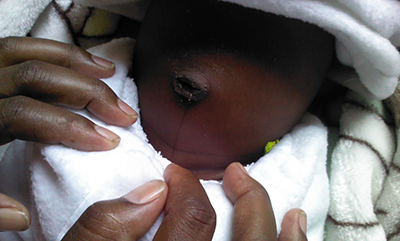Umbilical Cord Antiseptic Not Effective in Reducing Infant Deaths in Africa.
 Despite significant reductions in neonatal mortality previously reported in south Asia, applying a chlorhexidine wash to newborns’ umbilical cords in sub-Saharan Africa did not reduce deaths, a study led by researchers from the School of Public Health shows.
Despite significant reductions in neonatal mortality previously reported in south Asia, applying a chlorhexidine wash to newborns’ umbilical cords in sub-Saharan Africa did not reduce deaths, a study led by researchers from the School of Public Health shows.
The study, in The Lancet Global Health, calls into question recent efforts to scale up the use of antiseptic chlorhexidine cord washes globally, as a strategy to reduce neonatal sepsis and mortality.
“Although chlorhexidine is potentially beneficial in places with a high neonatal mortality rate and home-based delivery environments in south Asia, the treatment had no effect on neonatal mortality in Zambia, an environment with a lower neonatal mortality rate (and) more facility-based deliveries,” the study says.
“On the basis of these findings, we believe chlorhexidine should not be globally implemented, especially in moderate neonatal mortality environments in Africa.”
The results of the two-year study of more than 37,800 live births in Southern Province, Zambia, come as researchers worldwide have been trying to find ways to reduce neonatal mortality, defined as death within the first 28 days of life. Globally, 3 million newborns die each year, with infection responsible for approximately 13 percent of these deaths. Poor hygiene and antisepsis at birth and in the first week of life increases the risk of deadly but preventable infections.
Over the past decade, studies in Bangladesh, Nepal, and Pakistan all found that chlorhexidine washes, compared with dry cord care, reduced neonatal mortality rates—fueling optimism that the intervention would work in other settings.
But the new study and a companion trial in Pemba Island, Tanzania, indicate that those results are “not generalizable” to many sub-Saharan African countries, where antenatal care services are used more frequently; there are more facility-based deliveries; and neonatal mortality rates are generally lower. Fewer than 20 percent of the births in the three south Asian countries occurred at a health facility, compared to 63 percent of the births in Zambia.
“Rolling out chlorhexidine to all low-income and middle-income settings risks the misuse of resources – time, money, political capital, and most importantly, patient trust,” said senior study author David Hamer, a professor of global health and of medicine at the School of Medicine, who is a researcher with the Center for Global Health and Development.
He and co-principal investigator, Katherine Semrau, a former assistant professor of global health at SPH who is now a faculty member at Ariadne Labs and Harvard Medical School, said the study points to the need to identify more effective care that will reduce the risk of death in these lower mortality settings.
“We need to focus on the interventions that we know work in this context, such as the use of skilled birth attendants and neonatal resuscitation, which can go far to reducing infant mortality in resource-limited settings,” said Semrau.
The authors called for a rigorous analysis of all major trials of chlorhexidine cord care, to inform World Health Organization (WHO) policies.
WHO guidelines now recommend chlorhexidine applications to the umbilical cord stump during the first week of life for newborns who are born at home in locations with high neonatal mortality (>30 deaths/1000 live births). Clean, dry cord care is recommended for babies born in health facilities and at home in low neonatal mortality settings.
The authors pointed to several factors that could have influenced the Zambia study results, including that participants in both the chlorhexidine and control groups received information about newborn care that emphasized keeping the infants’ umbilical cords clean and dry. That might have resulted in better cord-care practices in the context of the trial, and lower mortality in both groups.
The study, known as ZamCAT (Zambian Chlorhexidine Application Trial), was funded by the Bill & Melinda Gates Foundation.
Co-authors are from the Center for Global Health and Development; the Zambian Ministry of Health and Ministry of Community Development, Mother, and Child Health; and the Zambia Centre for Applied Research and Development.